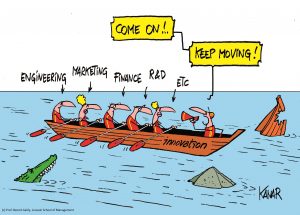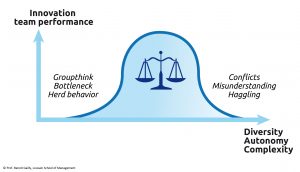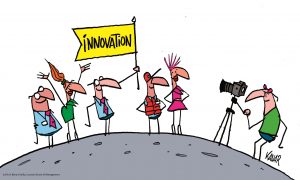 Organizations can successfully manage innovation only if they have the ability to build and lead effective project teams around their innovation initiatives.
Organizations can successfully manage innovation only if they have the ability to build and lead effective project teams around their innovation initiatives.
 An effective project team will become a great innovation team if it can manage key trade-offs in terms of level of pressure, diversity, slack and tolerance for diverging and outside perspectives.
An effective project team will become a great innovation team if it can manage key trade-offs in terms of level of pressure, diversity, slack and tolerance for diverging and outside perspectives.
 Building an effective innovation team means mobilizing transformational project leaders and team members with the right profiles, background, motivation and skills – not just whoever happens to be “on the bench” when the initiative is launched.
Building an effective innovation team means mobilizing transformational project leaders and team members with the right profiles, background, motivation and skills – not just whoever happens to be “on the bench” when the initiative is launched.
Bibliography
Why we need effective project teams to innovate
Keywords: project management, project teams, global teams, sponsor, teams, virtual teams
- (Book) Malone, T. W. (2018). Superminds: The Surprising Power of People and Computers Thinking Together. Little, Brown.
- (Book) Mumford, Michael D., ed. Handbook of organizational creativity. Academic Press, 2011.
- (Book) Penrose. E. (1959) The Theory of the Growth of the Firm
- (Book) Spinelli Jr, S., & McGowan, H. (2013). Disrupt together: How teams consistently innovate. Pearson Education.
- (Video) Chinese Bridge Maker Machine
- (Video) A Conference Call in Real Life
- (Article) Blindenbach-Driessen, F., & Van Den Ende, J. (2006). Innovation in project-based firms: The context dependency of success factors. Research Policy, 35(4), 545-561.
- (Article) Clark, Kim B., and Steven C. Wheelwright. “Organizing and leading” heavyweight” development teams.” California Management Review 34.3 (1992): 9-28.
- (Article) Cooney, T. M. (2005). What is an entrepreneurial team?. International Small Business Journal, 23(3), 226-236.
- (Article) Cozijnsen, A. J., Vrakking, W. J., & van IJzerloo, M. (2000). Success and failure of 50 innovation projects in Dutch companies. European Journal of Innovation Management, 3(3), 150-159.
- (Article) Druskat, V. U., & Wolff, S. B. (2001). Building the emotional intelligence of groups. Harvard Business Review, 79(3), 80-91.
- (Article) Gibson, Cristina B., and Jennifer L. Gibbs. “Unpacking the concept of virtuality: The effects of geographic dispersion, electronic dependence, dynamic structure, and national diversity on team innovation.” Administrative Science Quarterly 51.3 (2006): 451-495.
- (Article) Gilson, L. L., Maynard, M. T., Jones Young, N. C., Vartiainen, M., & Hakonen, M. (2015). Virtual teams research: 10 years, 10 themes, and 10 opportunities. Journal of Management, 41(5), 1313-1337.
- (Article) Hung, C. L., Kuo, S. J., & Dong, T. P. (2013). The relationship between team communication, structure, and academic R&D performance: empirical evidence of the national telecommunication program in Taiwan. R&D Management, 43(2), 121-135.
- (Article) Kor, Y.Y. and Mahoney, J.T. (2004). Edith Penrose’s (1959) Contributions to the Resource-based View of Strategic Management. Journal of Management Studies, 41, 183–191.
- (Article) Malone, T. W. (2018). How Human-Computer’Superminds’ Are Redefining the Future of Work. Sloan Management Review, 59(4), 34-41.
- (Article) Marks, M. A., Mathieu, J. E., & Zaccaro, S. J. (2001). A temporally based framework and taxonomy of team processes. Academy of Management Review, 26(3), 356-376.
- (Article) Pinto, M. B., Pinto, J. K., & Prescott, J. E. (1993). Antecedents and consequences of project team cross-functional cooperation. Management Science, 39(10), 1281-1297.
- (Article) Schoonhoven, C., Eisenhardt, K., & Lyman, K. (1990). ‘Speeding products to market: waiting time to first product introduction in new firms’. Administrative Science Quarterly, 35, 177-207.
- (Article) Smith, P.G., & Blanck, E.L. (2002). From experience: leading dispersed teams. Journal of Product Innovation Management, 19(4), 294-304.
- (Article) Smith, D. J. (2007). The politics of innovation: why innovations need a godfather. Technovation, 27(3), 95-104.
- (Article) Stewart, G. L. (2006). A meta-analytic review of relationships between team design features and team performance. Journal of Management, 32(1), 29-55.
- (Article) Von Hippel, E. (1994). “Sticky information” and the locus of problem solving: implications for innovation. Management Science, 40(4), 429-439.
- (Article) Wilson, K., & Doz, Y.L. (2012). 10 Rules for managing global innovation. Harvard Business Review, 90(10), 84-90.
- (Article) Wuchty, S., Jones, B. F., & Uzzi, B. (2007). The increasing dominance of teams in production of knowledge. Science, 316(5827), 1036-1039.
How to build great innovation teams – key trade-offs
Keywords: consensus, cross-fertilization, diversity, group dynamics, innovation teams, task orientation
- (Book) Johansson, F. (2004). The Medici effect: Breakthrough insights at the intersection of ideas, concepts, and cultures. Harvard Business Press.
- (Book) West, M. (2012) Effective teamwork. Practical lessons from organizational research. London: BPS Blackwell
- (Video) New Venture Teams, entrepreneurshipLU
- (Video) Cross-Functional Teams and Their Impact on Driving Innovation by Kuczmarski Innovation (on Vimeo)
- (Article) Ashforth, Blake E., and Fred Mael. “Social identity theory and the organization.” Academy of Management Review 14.1 (1989): 20-39.
- (Article) Amabile, T.M. (1998). How to kill creativity, Harvard Business Review, (September/October), 77-87.
- (Article) Bahar, D., Choudhury, P., & Rapoport, H. (2020). Migrant inventors and the technological advantage of nations. Research Policy, 49(9), 103947.
- (Article) Bernstein, E., Shore, J., & Lazer, D. (2018). How intermittent breaks in interaction improve collective intelligence. Proceedings of the National Academy of Sciences, 201802407.
- (Article) Bikard, M., Murray, F., & Gans, J. S. (2015). Exploring trade-offs in the organization of scientific work: Collaboration and scientific reward. Management Science, 61(7), 1473-1495.
- (Article) Campbell, D. T. (1960). Blind variation and selective retentions in creative thought as in other knowledge processes. Psychological Review, 67(6), 380.
- (Article) Chen, M. H., Chang, Y. C., & Hung, S. C. (2008). Social capital and creativity in R&D project teams. R&D Management, 38(1), 21-34.
- (Article) Choudhury, P., & Kim, D. Y. (2019). The ethnic migrant inventor effect: Codification and recombination of knowledge across borders. Strategic Management Journal, 40(2), 203-229.
- (Article) Chowdhury, S. (2005). Demographic diversity for building an effective entrepreneurial team: is it important?. Journal of Business Venturing, 20(6), 727-746.
- (Article) Cronin, M. A., & Weingart, L. R. (2007). Representational gaps, information processing, and conflict in functionally diverse teams. Academy of Management Review, 32(3), 761-773.
- (Article) Cummings, J. N. (2004). Work groups, structural diversity, and knowledge sharing in a global organization. Management Science, 50(3), 352-364.
- (Article) de Mol, E., Khapova, S. N., & Elfring, T. (2015). Entrepreneurial team cognition: A review. International Journal of Management Reviews, 17(2), 232-255.
- (Article) Edmondson, A. (1999). Psychological safety and learning behavior in work teams. Administrative Science Quarterly, 44(2), 350-383.
- (Article) Eisenbeiss, S., van Knippenberg, D., & Boerner, S. (2008). ‘Transformational Leadership and Team Innovation: Integrating Team Climate Principles’. Journal of Applied Psychology, 93, 1438-1446.
- (Article) Fleming, L. (2007). Breakthroughs and the” long tail” of innovation. MIT Sloan Management Review, 49(1), 69.
- (Article) Gilson, L. L., & Shalley, C. E. (2004). A little creativity goes a long way: An examination of teams’ engagement in creative processes. Journal of Management, 30(4), 453-470.
- (Article) Glynn, M. A., Kazanjian, R., & Drazin, R. (2010). Fostering innovation in complex product development settings: The role of team member identity and interteam interdependence. Journal of Product Innovation Management, 27(7), 1082-1095.
- (Article) Godart, F., Maddux, W., Shipilov, A., & Galinsky, A. (2015). ‘Fashion with a foreign flair: professional experiences abroad facilitate the creative innovations of organizations’. Academy of Management Journal, 58, 195-220.
- (Article) Guimera, R., Uzzi, B., Spiro, J., & Amaral, L. A. N. (2005). Team assembly mechanisms determine collaboration network structure and team performance. Science, 308(5722), 697-702.
- (Article) Gumusluoglu, L., & Ilsev, A. (2009). ‘Transformational leadership, creativity, and organizational innovation’. Journal of Business Research, 62, 461-473.
- (Article) Harrison, S. H., & Rouse, E. D. (2014). Let’s dance! Elastic coordination in creative group work: A qualitative study of modern dancers. Academy of Management Journal, 57(5), 1256-1283.
- (Article) Harvey, S. (2014). Creative synthesis: Exploring the process of extraordinary group creativity. Academy of Management Review, 39(3), 324-343.
- (Article) Harvey, J. F., Cromwell, J. R., Johnson, K. J., & Edmondson, A. C. (2023). The Dynamics of Team Learning: Harmony and Rhythm in Teamwork Arrangements for Innovation. Administrative Science Quarterly, 00018392231166635.
- (Article) Hauptman, O., & Hirji, K. K. (1999). Managing integration and coordination in cross‐functional teams: an international study of Concurrent Engineering product development. R&D Management, 29(2), 179-192.
- (Article) Hewlett, S. A., Marshall, M., & Sherbin, L. (2013). How diversity can drive innovation. Harvard Business Review, 91(12), 30-30.
- (Article) Hill, L. A., Brandeau, G., Truelove, E., & Lineback, K. (2014). Collective genius. Harvard Business Review, 92(6), 94-102.
- (Article) Hirst, G., Van Knippenberg, D., & Zhou, J. (2009). A cross-level perspective on employee creativity: Goal orientation, team learning behavior, and individual creativity. Academy of Management Journal, 52(2), 280-293.
- (Article) Hülsheger, Ute R.; Anderson, Neil; Salgado, Jesus F. (2009) Team-level predictors of innovation at work: A comprehensive meta-analysis spanning three decades of research. Journal of Applied Psychology, Vol 94(5), Sep 2009, 1128-1145
- (Article) Keller, R. T. (2001). Cross-functional project groups in research and new product development: Diversity, communications, job stress, and outcomes. Academy of Management Journal, 44(3), 547-555.
- (Article) Kollmann, T., Stöckmann, C., Meves, Y., & Kensbock, J. M. (2017). When members of entrepreneurial teams differ: linking diversity in individual-level entrepreneurial orientation to team performance. Small Business Economics, 48(4), 843-859.
- (Article) Kurtzberg, T. R., & Amabile, T. M. (2001). From Guilford to creative synergy: Opening the black box of team-level creativity. Creativity Research Journal, 13(3-4), 285-294.
- (Article) Leonard, D., & Straus, S. (1997) Putting your company’s whole brain to work. Harvard Business Review 75, 110-122.
- (Article) Leonard, O., Wiita, N. & Mialne, C. (2017) The Best Senior Teams Thrive on Disagreement. Harvard Business Review, Sep. 18, 2017
- (Article) Lingo, E. L., & O’Mahony, S. (2010). Nexus work: Brokerage on creative projects. Administrative Science Quarterly, 55(1), 47-81.
- (Article) Liu, Y., Keller, R. T., & Shih, H. A. (2011). The impact of team‐member exchange, differentiation, team commitment, and knowledge sharing on R&D project team performance. R&D Management, 41(3), 274-287.
- (Article) Melero, E., & Palomeras, N. (2015). ‘The Renaissance Man is not dead! The role of generalists in teams of inventors’. Research Policy, 44, 154-167.
- (Article) Morris, M.H., Davis, D.L., & Allen, J.W. (1994). Fostering corporate entrepreneurship: cross-cultural comparisons of the importance of individualism and collectivism. Journal of International Business Studies, 25(1), 65-89.
- (Article) Mueller, J. S., & Kamdar, D. (2011). Why seeking help from teammates is a blessing and a curse: A theory of help seeking and individual creativity in team contexts. Journal of Applied Psychology, 96(2), 263.
- (Article) Mumford, M., Scott, G., Gaddis, B., & Strange, J. (2002). ‘Leading creative people: orchestrating expertise and relationships’. Leadership Quarterly, 13, 705-750.
- (Article) Oldham, G. R., & Cummings, A. (1996). Employee creativity: Personal and contextual factors at work. Academy of Management Journal, 39(3), 607-634.
- (Article) Østergaard, C. R., Timmermans, B., & Kristinsson, K. (2011). Does a different view create something new? The effect of employee diversity on innovation. Research Policy, 40(3), 500-509.
- (Article) Page, S. E. (2007). Making the difference: Applying a logic of diversity. Academy of Management Perspectives, 21(4), 6-20.
- (Article) Reagans, R., & Zuckerman, E. W. (2001). Networks, diversity, and productivity: The social capital of corporate R&D teams. Organization Science, 12(4), 502-517.
- (Article) Shore, J., Bernstein, E., & Lazer, D. (2015). Facts and figuring: An experimental investigation of network structure and performance in information and solution spaces. Organization Science, 26(5), 1432-1446.
- (Article) Somech, A., & Drach-Zahavy, A. (2013). Translating team creativity to innovation implementation: The role of team composition and climate for innovation. Journal of Management, 39(3), 684-708.
- (Article) Taggar, S. (2002). Individual creativity and group ability to utilize individual creative resources: A multilevel model. Academy of Management Journal, 45(2), 315-330.
- (Article) Taylor, A., & Greve, H. R. (2006). Superman or the fantastic four? Knowledge combination and experience in innovative teams. Academy of Management Journal, 49(4), 723-740.
- (Article) Weiss, M., Hoegl, M., & Gibbert, M. (2014). Perceptions of material resources in innovation projects: What shapes them and how do they matter?. Journal of Product Innovation Management, 31(2), 278-291.
- (Article) West, M. A., & Anderson, N. R. (1996). Innovation in top management teams. Journal of Applied Psychology, 81(6), 680.
- (Article) West M.A. (2002). “Sparkling fountains or stagnant pounds” Applied psychology: an International Review, 5(3), 355-524.
- (Article) Wu, L., Wang, D., & Evans, J. A. (2019). Large teams develop and small teams disrupt science and technology. Nature, 566(7744), 378-382.
- (Article) Yang, T., Bao, J., & Aldrich, H. (2020). The Paradox of Resource Provision in Entrepreneurial Teams: Between Self-Interest and the Collective Enterprise. Organization Science.
Transformational team leader and members
Keywords: autonomy, team member, transformational leadership
- (Book) Damasio, A. R. (2006). Descartes’ error. Random House
- (Book) Galinsky, A., & Schweitzer, M. (2015). Friend & foe: When to cooperate, when to compete, and how to succeed at both. Crown Business.
- (Video) How to be an Innovative Leader: A Jam Session with Stanford Faculty
- (Video) Transforming transformational leadership | Lesley Hayes | TEDxBrentwoodCollegeSchool
- (Article) Amabile, T. M., Schatzel, E. A., Moneta, G. B., & Kramer, S. J. (2004). Leader behaviors and the work environment for creativity: Perceived leader support. The Leadership Quarterly, 15(1), 5-32.
- (Article) Amabile, T. M., & Khaire, M. (2008). Creativity and the Role of the Leader. Harvard Business Review, 86(10).
- (Article) Ancona, D., Malone, T.W., Orliwoski, W.J. & Senge, P. (2007) In praise of the incomplete leader. Harvard Business Review, (Feb), 92-100
- (Article) Anderson, N. R., & West, M. A. (1998). Measuring climate for work group innovation: development and validation of the team climate inventory. Journal of Organizational Behavior, 235-258.
- (Article) Avolio, B., Bass, B., & Jung, D. (1999). ‘Re-examining the components of transformational and transactional leadership using the multifactor leadership questionnaire’. Journal of Occupational and Organizational Psychology, 72, 441-462.
- (Article) Azoulay, P., Graff Zivin, J. S., & Wang, J. (2010). Superstar extinction. The Quarterly Journal of Economics, 125(2), 549-589.
- (Article) Basadur, M. (2004). Leading others to think innovatively together: Creative leadership. The Leadership Quarterly, 15(1), 103-121.
- (Article) Bass, B. M. (1990). From transactional to transformational leadership: Learning to share the vision. Organizational Dynamics, 18(3), 19-31.
- (Article) Bass, B. M., Avolio, B. J., Jung, D. I. & Berson, Y. 2003. Predicting unit performance by assessing transformational and transactional leadership. Journal of Applied Psychology, 88, 207.
- (Article) Cardon, M. S., Post, C., & Forster, W. R. (2017). Team entrepreneurial passion: Its emergence and influence in new venture teams. Academy of Management Review, 42(2), 283-305.
- (Article) Chamorro-Premuzic, T. (2013). Why do so many incompetent men become leaders. Harvard Business Review, 22.
- (Article) Chen, M. H. (2007). Entrepreneurial leadership and new ventures: Creativity in entrepreneurial teams. Creativity and Innovation Management, 16(3), 239-249.
- (Article) Davis, J., & Eisenhardt, K. (2011). ‘Rotating Leadership and Collaborative Innovation: Recombination Processes in Symbiotic Relationships’. Administrative Science Quarterly, 56, 159-201.
- (Article) Den Hartog, D., Van Muijen, J., & Koopman, P. (1997). ‘Transactional versus transformational leadership: an analysis of the MLQ’. Journal of Occupational and Organizational Psychology, 70, 19-34.
- (Article) Engelen, A., Gupta, V., Strenger, L., & Brettel, M. (2015). Entrepreneurial Orientation, Firm Performance, and the Moderating Role of Transformational Leadership Behaviors. Journal of Management, 41(4), 1069-1097.
- (Article) Ensley, M. D., Hmieleski, K. M., & Pearce, C. L. (2006). The importance of vertical and shared leadership within new venture top management teams: Implications for the performance of startups. The Leadership Quarterly, 17(3), 217-231.
- (Article) Furr, N., Nel, K. & Ramsoy, T.Z. (2018) If Your Innovation Effort Isn’t Working, Look at Who’s on the Team. Harvard Busines Review, November 09
- (Article) Garcia-Morales, V., Jimenez-Barrionuevo, M., & Gutierrez-Cutierrez, L. (2012). ‘Transformational leadership influence on organizational performance through organizational learning and innovation’. Journal of Business Research, 65, 1040-1050.
- (Article) Gumusluoglu, L., & Ilsev, A. (2009). ‘Transformational Leadership and Organizational Innovation: The Roles of Internal and External Support for Innovation’. The Journal of Product Innovation Management, 26, 264-277.
- (Article) Hornsby, J.S., Kuratko, D.F., Shepherd, D.A., & Bott, J.P. (2009). Managers’ corporate entrepreneurial actions: Examining perception and position. Journal of Business Venturing, 24(3), 236-247.
- (Article) Jung, D.I. et al. (2003) The role of transformational leadership in enhancing organizational innovation, The Leadership Quarterly 14, 525–544
- (Article) Kickul, J., & Gundry, L. (2002). Prospecting for strategic advantage: The proactive entrepreneurial personality and small firm innovation. Journal of Small Business Management, 40(2), 85-97.
- (Article) Lowe, K. B., Kroeck, K. G., & Sivasubramaniam, N. (1996). Effectiveness correlates of transformational and transactional leadership: A meta-analytic review of the MLQ literature. The Leadership Quarterly, 7(3), 385-425.
- (Article) Miron-Spektor, E., Erez, M., & Naveh, E. (2011). The effect of conformist and attentive-to-detail members on team innovation: Reconciling the innovation paradox. Academy of Management Journal, 54(4), 740-760.
- (Article) Montes, F. J. L., Moreno, A. R., & Morales, V. G. (2005). Influence of support leadership and teamwork cohesion on organizational learning, innovation and performance: an empirical examination. Technovation, 25(10), 1159-1172.
- (Article) Rafferty, A. E., & Griffin, M. A. (2004). Dimensions of transformational leadership: Conceptual and empirical extensions. The Leadership Quarterly, 15(3), 329-354.
- (Article) Redmond, M. R., Mumford, M. D., & Teach, R. (1993). Putting creativity to work: Effects of leader behavior on subordinate creativity. Organizational Behavior and Human Decision Processes, 55(1), 120-151.
- (Article) Roach, M., & Sauermann, H. (2015). Founder or joiner? The role of preferences and context in shaping different entrepreneurial interests. Management Science, 61(9), 2160-2184.
- (Article) Sendjaya, S., Sarros, J. C., & Santora, J. C. (2008). Defining and measuring servant leadership behaviour in organizations. Journal of Management Studies, 45(2), 402-424.
- (Article) Shalley, C. E., & Gilson, L. L. (2004). What leaders need to know: A review of social and contextual factors that can foster or hinder creativity. The Leadership Quarterly, 15(1), 33-53.
- (Article) Shin, S. J., & Zhou, J. (2003). Transformational leadership, conservation, and creativity: Evidence from Korea. Academy of Management Journal, 46(6), 703-714.
- (Article) Somech, A. (2006). The effects of leadership style and team process on performance and innovation in functionally heterogeneous teams. Journal of Management, 32(1), 132-157.
- (Article) Uhl-Bien, M., Riggio, R. E., Lowe, K. B., & Carsten, M. K. (2014). Followership theory: A review and research agenda. The Leadership Quarterly, 25(1), 83-104.
- (Article) West, M. A., Borrill, C. S., Dawson, J. F., Brodbeck, F., Shapiro, D. A., & Haward, B. (2003). Leadership clarity and team innovation in health care. The Leadership Quarterly, 14(4-5), 393-410.
- (Article) Yoshida, D. T., Sendjaya, S., Hirst, G., & Cooper, B. (2014). Does servant leadership foster creativity and innovation? A multi-level mediation study of identification and prototypicality. Journal of Business Research, 67(7), 1395-1404.
- (Article) Yukl, G. (1989). Managerial leadership: A review of theory and research. Journal of Management, 15(2), 251-289.
- (Article) Yukl, G. (1999). An evaluation of conceptual weaknesses in transformational and charismatic leadership theories. The Leadership Quarterly, 10(2), 285-305.
- (Article) Zaleznik, A. (2004). Managers and leaders. Harvard Business Review, 1.
(c) Prof. Benoit Gailly, Louvain School of Management


